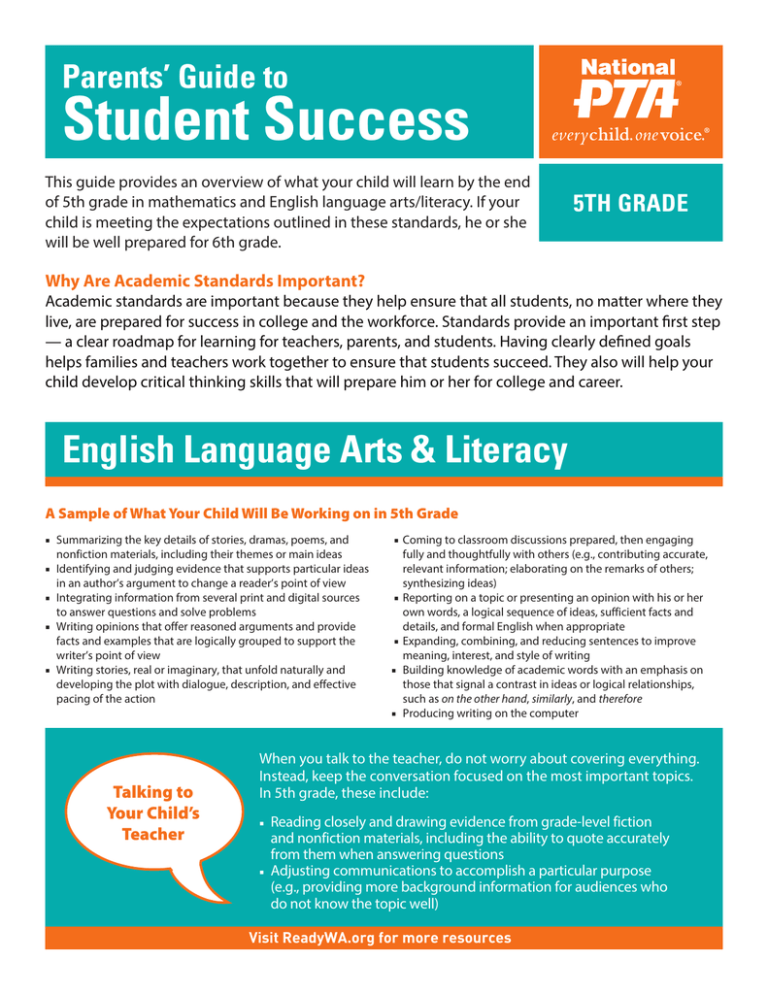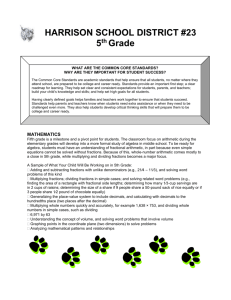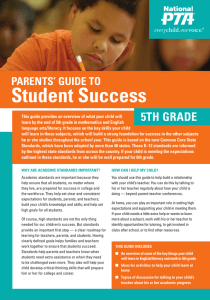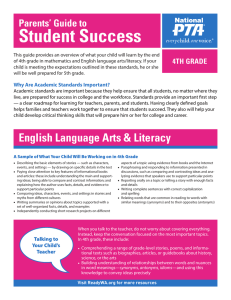Student Success Parents’ Guide to
advertisement

Parents’ Guide to Student Success This guide provides an overview of what your child will learn by the end of 5th grade in mathematics and English language arts/literacy. If your child is meeting the expectations outlined in these standards, he or she will be well prepared for 6th grade. 5th grade Why Are Academic Standards Important? Academic standards are important because they help ensure that all students, no matter where they live, are prepared for success in college and the workforce. Standards provide an important first step — a clear roadmap for learning for teachers, parents, and students. Having clearly defined goals helps families and teachers work together to ensure that students succeed. They also will help your child develop critical thinking skills that will prepare him or her for college and career. English Language Arts & Literacy A Sample of What Your Child Will Be Working on in 5th Grade ■ Summarizing the key details of stories, dramas, poems, and nonfiction materials, including their themes or main ideas ■ Identifying and judging evidence that supports particular ideas in an author’s argument to change a reader’s point of view ■ Integrating information from several print and digital sources to answer questions and solve problems ■ Writing opinions that offer reasoned arguments and provide facts and examples that are logically grouped to support the writer’s point of view ■ Writing stories, real or imaginary, that unfold naturally and developing the plot with dialogue, description, and effective pacing of the action Talking to Your Child’s Teacher ■ Coming to classroom discussions prepared, then engaging fully and thoughtfully with others (e.g., contributing accurate, relevant information; elaborating on the remarks of others; synthesizing ideas) ■ Reporting on a topic or presenting an opinion with his or her own words, a logical sequence of ideas, sufficient facts and details, and formal English when appropriate ■ Expanding, combining, and reducing sentences to improve meaning, interest, and style of writing ■ Building knowledge of academic words with an emphasis on those that signal a contrast in ideas or logical relationships, such as on the other hand, similarly, and therefore ■ Producing writing on the computer When you talk to the teacher, do not worry about covering everything. Instead, keep the conversation focused on the most important topics. In 5th grade, these include: Reading closely and drawing evidence from grade-level fiction and nonfiction materials, including the ability to quote accurately from them when answering questions ■ Adjusting communications to accomplish a particular purpose (e.g., providing more background information for audiences who do not know the topic well) ■ Visit ReadyWA.org for more resources Mathematics A Sample of What Your Child Will Be Working on in 5th Grade ■ Adding and subtracting fractions with unlike denominators (e.g., 21⁄4 – 11⁄3), and solving word problems of this kind ■ Multiplying fractions; dividing fractions in simple cases; and solving related word problems (e.g., finding the area of a rectangle with fractional side lengths; determining how many 1⁄3-cup servings are in 2 cups of raisins; determining the size of a share if 9 people share a 50-pound sack of rice equally or if 3 people share 1⁄2 pound of chocolate equally) ■ Generalizing the place-value system to include decimals, and calculating with decimals to the hundredths place (two places after the decimal) ■ Multiplying whole numbers quickly and accurately, for example 1,638 × 753, and dividing whole numbers in simple cases, such as dividing 6,971 by 63 ■ Understanding the concept of volume, and solving word problems that involve volume ■ Graphing points in the coordinate plane (two dimensions) to solve problems ■ Analyzing mathematical patterns and relationships When you talk to the teacher, do not worry about covering everything. Instead, keep the conversation focused on the most important topics. In 5th grade, these include: Talking to Your Child’s Teacher ■ Multiplying and dividing fractions, and solving related word problems ■ Decimals (concepts and arithmetic) ■ Volume (concepts and problem-solving) Help Your Child Learn at Home Try to create a quiet place for your child to study, and carve out time every day when your child can concentrate. You should also try to sit down with your child at least once a week for 15 to 30 minutes while he or she works on homework. This will keep you informed about what your child is working on, and it will help you be the first to know if your child needs help with specific topics. Additionally, here are some activities you can do with your child to support learning at home: English Language Arts & Literacy Mathematics ■ Invite your child to read his or her writing out loud to other family members. Ask questions about your child’s word choices and ideas. ■ Go to a play or musical with your child. Discuss the way the actors bring the words to life. ■ Discuss your family stories and history. Encourage your child to ask relatives questions about their lives. Put the information together in an album or brainstorm different ways to tell family tales, such as poems or short stories. Look for “word problems” in real life. Some 5th grade examples might include: ■ Doing arithmetic with decimals, for example when balancing a checkbook. ■ Multiplying with fractions — for example, if you used about 2⁄3 of a 3⁄4-cup measure of vegetable stock, then how much stock did you use? About how much is left? ■ Using the length, width, and depth of a garden plot to determine how many bags of garden soil to buy. For more information, the full standards are available at www.corestandards.org. National Office: 1250 N Pitt Street • Alexandria, VA 22314 • Toll-Free: (800) 307-4PTA (4782) • PTA.org • info@pta.org © 2012 PTA All rights reserved. Printed in U.S.A. (9/12) • and everychild.onevoice.® are registered service marks of the National Congress of Parents and Teachers. Visit ReadyWA.org for more resources




